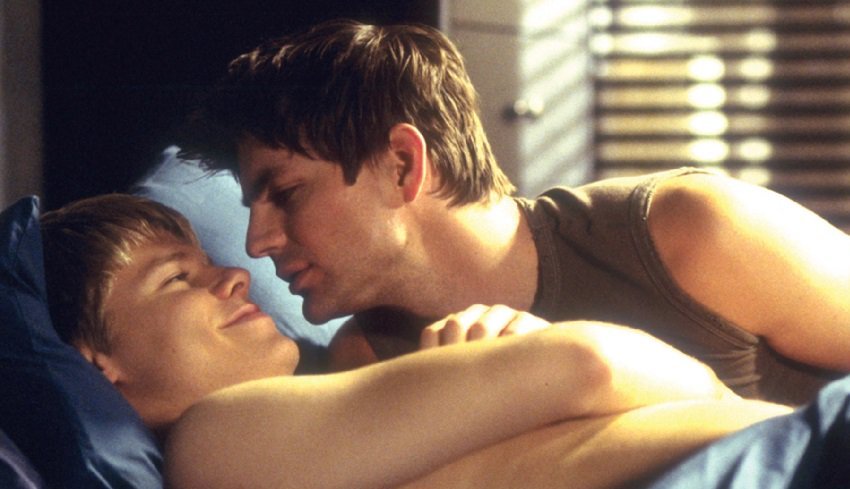Why Queer as Folk USA remains essential viewing more than two decades later
The Stateside series was so much more than just a spin-off, writes Shaun Kitchener.

Words: Shaun Kitchener
This article was first published in June 2018
The British version of Russell T Davies’ game-changing Queer As Folk is rightly regarded as one of the most important shows in LGBT+ television history. But it’s much less appreciated (over here in the UK, at least) US remake, which ran for five seasons and ended in 2005, also deserves a lot of love.
For a start, it had so much more of a life than the Manchester-set original. While Aiden Gillen’s Stuart, Craig Kelly’s Vincent and Charlie Hunnam’s Nathan were only seen for ten episodes, Gale Harold’s Brian, Hal Sparks’ Michael and Randy Harrison’s Justin had a far lengthier 83; allowing far more time to explore a vast range of boundary-breaking issues, flesh out various characters and squeeze in God knows how many sex scenes.
Over the course of its five years on the air, QAF USA covered basically everything related to the modern gay experience: coming out, marriage, HIV and serodiscordant relationships, ‘bug chasing’, drug use and abuse, multiple forms of homophobia, cruising, adoption… and, in most cases, it tackled its subject matter with great success.
From Justin’s dad’s reaction to his sexuality in season one to the threat of government-induced discrimination in season five, it navigated difficult topics with delicacy and, in many places – especially whenever Sharon Gless’s wonderful Debbie was involved – humour.

Of course, as with any long-running show, it wasn’t a perfect ride: there were occasional episodes that fell flat and subplots that struggled to hit the mark (the execution of Ted’s descent into crystal meth addiction, for example, was brilliantly acted but had its wobbles).
It’s also a shame that the tally of BME (black and minority ethnic) characters was so low. Still, at the turn of the century, there simply wasn’t another show on American television doing what Queer As Folk was daring to do.
Co-creator Ron Cowen recently revealed that agents were refusing to put their clients up for the roles (“Actors that we knew actually told us that their agents told them not to go up for Queer as Folk… it was because of the content of the show, it being a show about gay people”), while Gless has said that she doesn’t even know how many networks were offered the broadcast rights before Showtime eventually said yes. But what an important project it turned out to be.
For a start, the opening episode’s gay sex scenes were the first to ever be seen in an American drama. More than that, it was one of the biggest shows ever to feature gay characters at the front of the narrative at all, rather than as dead bodies on crime dramas or two-dimensional ‘gay best friends’.
Over the course of its half a decade in action, QAF explored so many different colours of the gay community and explored the struggles so many of us face, regardless of sexuality: job loss, infidelity, commitment, addiction, dating, falling in love.
And it worked: Queer As Folk quickly became the biggest draw on the cable network’s roster and gave young people worldwide the courage to feel confident in their own skin and come out to their loved ones. 
After airing for five years, its finale broadcast on August 7, 2005, and the debate over whether or not the ending was a fitting farewell or a damp cop-out has continued to dominate message boards and fans’ dedicated Twitter accounts ever since (beware spoilers here, by the way).
While most of the spectacular events of the closing season happened in the run-up to Episode 13 rather than in it – the Babylon bombing, Brian saying ‘I love you’, Emmett and Drew parting ways – each character arguably did get the ending that felt most right for them: Brian and Justin’s wedding – a prospect which threatened to derail everything we thought we knew about their relationship – was mercifully called off (“Whether we see each other next week, next month, never again, it doesn’t matter. It’s only time.”), Hunter was officially adopted by Michael and Ben, and a fully reunited Lindsay and Melanie buggered off to start a new life across the Canadian border.
Above all, though, it was the impromptu speech (above) Michael delivered to a packed-out press conference that really summed-up what the show had come to be about. After being coerced into reciting a pre-written monologue about how gays are just like “normal” everyday suburban families, he said: “Do we all have to have the same lives to have the same rights? Being different is what makes us all the same. It’s what makes us family.”
Though it wasn’t always executed flawlessly, that was the message strived to deliver and, for the most part, it was a resounding success. There had never been a show like it, and – even taking shows like Looking into consideration – there hasn’t been another since.
